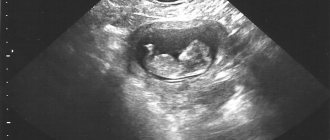You are already 4 months pregnant. You probably don’t know the gender of the baby yet, but would really like to find out?! Around this time, signs of toxicosis disappear in expectant mothers, their well-being improves, and their appetite increases. Now you can fully enjoy your position, but do not forget about the life developing within you. Be sure to see your doctor and follow all recommendations. If you were prescribed an ultrasound at 16 weeks of pregnancy, then the information provided will be very useful to you.
What happens to the fetus?
At 16 weeks of pregnancy, the unborn baby reaches the size of a ripe grapefruit. It already has distinguishable limbs, the legs become longer than the arms. The embryo's ears gradually move from the neck to their proper place. Changes also occur in the eyes; they take on a natural shape and position. The baby's eyelids are still closed, but he can clearly distinguish between light and dark, and his pupils move quickly. If you direct a bright beam at the belly, the baby will try to cover his face with his arms. The baby continues to move every minute: he kicks his legs, clenches his fists, rolls over. The mother may not feel this yet, but some women report the first movements at this time.
Internal organs continue to work at full capacity. Some of them change their function. The tiny heart beats almost twice as fast as mom’s: it pumps up to 28 liters of blood per day. The intestines and stomach work by digesting the amniotic fluid, releasing the necessary elements and nutrients. Urine is released hourly, but the baby is in no hurry to empty its bowels. Normally, the first feces will be released only after birth. The skin of the baby is still very thin and transparent; it has a reddish tint due to the fact that it is penetrated by small vessels.
Features of the 16 week period
At the 16th week of pregnancy - this is the second trimester - girls stop feeling insidious toxicosis, their appetite increases, and therefore the fetus begins to receive more nutrients (vitamins, minerals and much more). The psychological state of pregnant women also stabilizes; there are no obvious mood swings. Thanks to such comfortable conditions (mother’s peace of mind and good nutrition), the fetus begins to grow and develop much faster, which becomes clearly visible, because the pregnant woman’s belly is also growing.
Although the baby at this stage is the size of an avocado, its weight varies between 11 and 15 grams, and its height is 107-117 millimeters, but many pregnant women are already beginning to feel their baby moving. As a rule, during this period both the fetus and the mother feel well, but if something goes wrong, pain or unreasonable weakness appears, you should immediately contact the gynecologist with whom you are registered.
- The belly grows rapidly;
- Breast size increases significantly;
- The general condition is calm, psychologically balanced, painless;
- The first felt shocks of the fetus;
- Pigment spots are possible on a pregnant woman's body;
- There may be shortness of breath, because the child requires oxygen.
How does the fetus feel at the 16th week of pregnancy:
- The child begins to turn his head;
- Your baby's heart is working at full capacity;
- The child’s liver, having such a tiny size, already takes part in digestion;
- The function of the bladder and kidneys began to work;
- The circulatory system is already fully formed;
- The length of the legs exceeds the length of the arms;
- Fetal physical activity increases;
- His eyes open and he can blink;
- The baby is growing: the mother’s breathing may be difficult, as the uterus begins to put pressure on the diaphragm;
- The baby can hear loud sounds, but not clearly yet.
- Be careful about the positions in which you sleep. The most optimal position from this period until childbirth will be on the side, so as not to cause inconvenience to the child and unnecessary problems to yourself;
- Nutrition should be improved as much as possible. Introduce vitamins, minerals, proteins, fats and carbohydrates into your diet as much as possible. The baby will draw everything he needs from you, but you, too, must remain full of strength and energy. This is still less than half the term;
- Under no circumstances should you be nervous for any reason, remain calm and balanced;
- Starting from the 16th week, the gynecologist prescribes prenatal screening (ultrasound and blood tests). This examination will help to identify whether the child has any abnormalities, developmental disorders, pronounced pathologies, as well as whether there are signs indicating Down or Edwards syndrome. Of course, even if the tests are unsatisfactory, this is not a final diagnosis. To clarify it, you will need to visit and get a consultation with a geneticist and take additional tests. The preliminary diagnosis may well turn out to be a false positive; the most important thing is not to be too nervous during this period, so as not to inadvertently harm the child. If the diagnosis is confirmed, the choice will always be yours. No one has the right to deprive you of a child without your consent.
Ultrasonography
If you are 16 weeks pregnant, you will most likely not be scheduled for a scan. Such a recommendation is given in connection with special circumstances. Diagnostics is indicated for women who are at risk of miscarriage. This condition manifests itself as pain in the body and lower back, and bloody discharge. Diagnostics are carried out to clarify the gestational age, determine the sex, and identify any pathologies in the child.
Transabdominal ultrasound
Many women worry that ultrasound can harm the fetus by irradiating it. But this is a strong misconception. During diagnosis, data is supplied to the monitor using ultrasonic waves repelled from the tissues of the uterus and embryo. Thus, no harmful radiation exposure occurs.
Diagnostics can be performed throughout pregnancy as many times as necessary. It is much more dangerous to miss the right moment and lose the opportunity to change or correct something.
Possible problems
During an examination with ultrasound waves, some problems can be diagnosed. The most common ones include:
Size discrepancies
For some reason, the size of the fetus may be behind or ahead of its peers in parameters. Do not pay attention to minor fluctuations that do not exceed a few millimeters. However, there are some parameters that show an advance or lag of more than two weeks in obstetric terms. In this case, the woman is prescribed mandatory additional diagnostics.
The reasons may lie in insufficient nutrition, oxygen starvation, a predisposition to large or low weight, and genetic pathologies. More accurate information can be obtained after a repeat ultrasound performed 2 weeks later. Usually a woman is sent for a scan between 18 and 21 weeks.
Gender mismatch
Often parents are interested in the sex of the embryo. So, the 16th week of pregnancy is enough time to determine the sex of the baby during a scan. However, there are cases of receiving incorrect information. The doctor can give the most accurate result when the fetus reaches 20 weeks, and only if it lies comfortably. It often happens that the baby seems to be shy, and during the diagnosis he turns sideways towards the diagnostician. Thus, hiding your “charms”.
When the fetus is sitting in a pelvic position, with its back to the sensor, viewing the organs will be quite difficult. A doctor may make a mistake if a boy’s penis is hidden between his legs. In this case, he is often mistaken for a girl. The identification of girls can be erroneous if the umbilical cord loop gets between their legs. Then it is interpreted as the boy's penis.
Brain cysts
An ultrasound examination performed at week 16 can determine the presence of a cerebral plexus cyst. In this case, there is no need to panic, since stress will be much more harmful to the baby than a diagnosed cyst. The cyst appears as a fluid formation as a result of echographic findings. The vessels of the brain produce fluid plexuses that do not pose a danger to the health and development of the fetus.
The cyst does not grow or degenerate into a tumor. Identification of a cyst during scanning does not lead to a diagnosis. The doctor simply establishes the fact of its presence. This is not a pathology. Typically, after birth or during the first year of life, cysts resolve on their own.
Brain asymmetry
If the scan reveals the presence of brain asymmetry, the woman will need to undergo additional testing. Since such a pathology often occurs as a result of hypoxia experienced by the fetus. Most often, brain asymmetry occurs as a result of infectious diseases suffered by the mother in the first trimester, due to the presence of a tumor in the fetus.
A large degree of asymmetry indicates a risk of developing hydrocephalus. In this situation, the woman is advised to visit a neurosurgeon during pregnancy. A decision may be made to provide assistance to the baby immediately after birth. In addition, with a scan it is possible to determine the possibility of developing Down syndrome by examining the thickness of the baby's collar zone. This sign is the main indicator of this pathology.
An invisible nasal bone may be a sign of Edwards syndrome. Also at this time it is possible to recognize pathologies of the fetal neural tube, examine the spine and the features of its development. An ultrasound examination at week 16 is not routine, but in some cases this diagnosis is necessary. It allows you to assess the development of the fetus and detect the presence of serious diseases.
Why is ultrasound necessary?
At week 16, an ultrasound scan is mandatory for those women who, for some reason, missed the first screening. The study allows us to identify embryo pathologies that are incompatible with life or require correction. Diagnostics is necessary to establish the exact duration of pregnancy and the expected date of birth.
Ultrasound allows you to find out the following:
- possible detachment of the ovum and hematoma formation;
- tone and hypertonicity of the uterine walls, distortion of the shape of the fertilized egg;
- the place where the placenta is attached, whether it is presenting;
- number of embryos and their gender;
- presence or absence of the corpus luteum;
- condition of the cervix, possible premature opening.
If the doctor recommends doing research at this time, then it is really necessary. Refusal to undergo an examination can have disastrous consequences.
Traveling at 16 weeks of pregnancy
If the expectant mother is in good health, she may not deny herself travel. Naturally, it is better to discuss your plans with a doctor, who will express his opinion and give valuable recommendations. Before your trip, write down your doctor's phone number and, if necessary, call him for advice.
Among the important things you take with you should be a first aid kit with remedies for headaches, stomach upsets and to reduce acidity. It is better to coordinate all medications with your doctor and not take anything on your own without his instructions.
Rest should be competent, without adventures and strong emotional upheavals. Visit spa salons, beautiful places, parks, museums, relax and enjoy every minute.
It is better not to travel long distances, but limit yourself to nearby resorts and routes.
Features of scanning
Transvaginal ultrasound during pregnancy
From about 12 weeks, the growing uterus begins to leave the pelvic area, rising above it. Therefore, at week 16, an ultrasound is performed through the abdominal wall. The doctor uses a special sensor that needs to be applied to the stomach. The diagnosis does not require any preparation . If it is very difficult to examine the baby, the specialist can replace the transabdominal sensor with a transvaginal one. In this case, the study involves inserting the device into the vagina. Women with threatened miscarriage or cervical insufficiency should not be subjected to such manipulations.
Findings and next steps
After the 16th week ultrasound is done, the specialist will provide you with a protocol. It describes the results obtained during the study and measurements of the fetus. Normal values are also often indicated nearby. You shouldn’t compare them yourself, because you won’t be able to understand anything. A discrepancy in one or more values can be both normal and evidence of deviation. The ultrasound specialist's conclusion also cannot be considered a diagnosis .
The final verdict is made by the gynecologist, taking into account all the individual characteristics of the pregnant woman. Be sure to contact your obstetrician, who will help decipher the protocol.
Norms of values for a given period
As you understand, not all expectant mothers have an ultrasound scan at 16 weeks that shows the proper values. Some representatives of the fairer sex have deviations in one direction or another. Is this always a sign of serious pathology? Let's consider which values are considered satisfactory.
- The biparietal size of the baby's head is in the range from 3 to 3.7 centimeters.
- The fronto-occipital zone is 4.1-4.9 centimeters.
- The circumference of the head is 11.2-13.2 cm, and the tummy is 8.8-11.6 cm.
- The length of the femur is at least 1.7, but not more than 2.3 centimeters.
- The size of the shoulder and lower leg is approximately the same, it averages 1.5-2.1 centimeters.
- The forearm is about 1.5 centimeters (1.2 to 1.8).
- The baby's body weight can vary from 90 to 110 grams, and his height is already 10-12 centimeters.
- The amount of amniotic fluid is no more than 200, but not less than 70 milliliters.
- The placenta can have a size from 13 to 23 centimeters and can be located at any point of the reproductive organ.
An ultrasound performed at 16 weeks of pregnancy may show that the placenta is fully formed and the umbilical cord has three vessels. It is thanks to them that the baby receives the necessary nutrients, nutrients and vitamins.
Obtained results
The thickness and length of the cervix changes depending on the trimester.
- Until the 12th week of pregnancy, the normal cervical length is 3-5 cm. The organ has a dense consistency and is shown in the picture as a uniform gray color. Both uterine pharynxes are tightly closed.
- Until the 24th week, the length of the organ does not exceed 3 cm. In primiparous women, both uterine pharynxes are tightly closed; in multiparous women, the external one is allowed to open slightly.
- By week 36, the length is 2 cm, the consistency softens. In the picture, the organ is shown in dark gray. The external os is completely open.
In addition to the size of the cervix, various diseases are detected using ultrasound.
- Polyp is a benign growth of the mucous membrane. It is located inside the cervical canal and is shown in the picture as a gray rounded formation.
- Cancer is a malignant tumor. Grows inside or outside the cervical canal. It is presented in dark gray or white color and has an irregular shape.
Endometriosis is the growth of the lining of the uterus outside of it. The image shows dark irregular growths inside the cervical canal.
These diseases can cause premature birth. When diagnosing a malignant tumor, a cesarean section is recommended.
Deviations from the norm: what is the danger?
At this time, some of the treated data may not fit into normal values. In this situation, doctors suspect congenital anomalies of the embryo. But these can only be confirmed with the help of additional research.
On the left is a normal fetus, on the right is a fetus with signs of Down syndrome: increased thickness of the nuchal space (TN) and absent septum
At 16 weeks of pregnancy, an ultrasound can determine the excess thickness of the space behind the neck: the collar zone. This is an indirect sign of Down syndrome. The same is indicated by the presence of a nasal bone. The absence of the neural tube or its improper closure indicates a dangerous anomaly. Scanning during this period can already determine the absence of the brain and cranial vault . This reports a rare disease: anencephaly. The absence of limbs, certain organs, established congenital anomalies - everything is an indirect indication for termination of pregnancy. The last decision always remains with the woman, think carefully several times.
If we talk about less serious pathological processes, we can mention detachment or placenta previa, its premature aging. These ailments can be easily corrected with the help of modern drugs and techniques. Timely intervention and therapy can help avoid more serious disorders in the baby’s development. This is another reason why you should definitely have a scheduled ultrasound at 16 weeks.
The baby's place, which covers the pharynx, can still rise quite high, because there are two whole trimesters ahead. If the size of the baby is smaller than the norm, then the baby may still be able to catch up. But it is worth taking this fact into account and periodically conducting unscheduled studies to exclude intrauterine growth retardation.
Determining the gender of the child
At 16 weeks, the formation of the genital organs occurs. Boys develop a penis and scrotum, but the testicles still remain in the abdomen. They will descend into the proper zone only towards the end of the pregnancy. In some children, the testicles return to their normal position only after birth. This is not a deviation, but if a boy was born with undescended testicles, then you should definitely see a surgeon and take control of this process.
Determining the sex of the child. There is a boy in the photo.
In girls, during this period, the fallopian tubes and uterus are formed. The ovaries contain more than five million eggs. By the time of birth there will be no more than one and a half million of them left. Interestingly, by the onset of puberty, the number of eggs is no more than 300 thousand.
At sixteen weeks of pregnancy, it is not difficult to determine the sex of the unborn baby . If a specialist has good equipment and experience, determining the type of child is possible with maximum reliability. In girls, the labia are clearly visible, visible on the monitor in the form of three dots. Boys have a visible penis. It is often confused with the umbilical cord passing between the legs. In this case, the specialist mistakenly prophesies a son for the woman, but a daughter is born. Such cases occur very often. However, it is almost impossible to establish a pregnancy with a girl when a boy is expected at 16 weeks.
Summarize
As it became known, ultrasound diagnostics performed at 16 weeks of pregnancy can be very useful. The scanner does not have any harmful effects on the fetus. This can reveal very important points. What doctors look at is extremely important for you. For some couples, it is important to establish what gender their baby is, since many genetic diseases are transmitted along a certain line. One of these is hemophilia.
After completing the study, at this time you can determine the expected date of birth as accurately as possible. You can also make sure that the baby is developing in accordance with the deadline. Modern equipment even allows you to capture the image of a baby. Surely every mother can’t wait to see the baby. Follow your doctor's recommendations and complete all tests on time. Best wishes!
When, why and how is an ultrasound of the cervix done during pregnancy?
During pregnancy, the cervix undergoes some transformations and, depending on its condition, using this method it is possible to identify the danger of miscarriage or premature labor.
Normally, the state of the organ in expectant mothers is dense, the canal is closed, and there is a mucus plug at the exit. Ultrasound of the cervix during pregnancy, if indicated, can be prescribed from the earliest stages and helps monitor the health of the expectant mother.
Indications for the procedure
A woman's cervical size is monitored throughout her pregnancy.
One of the most common causes of early miscarriage is isthmic-cervical insufficiency.
Medical practice shows that this pathology in women most often ends in termination of pregnancy.
With this pathological condition, painless dilatation of the cervix of the reproductive organ is observed, which mainly occurs in the middle of the term or the beginning of the third trimester.
The reason for termination of pregnancy is that the fertilized egg lacks support in the lower segment and this is due to the poor condition of the muscle ring.
In addition, the neck of the reproductive organ is greatly softened and shortened, and this condition is complicated by the gaping of the cervical canal and internal pharynx.
While expecting a baby, the pressure inside the uterus gradually increases and the consequence of this is the displacement of the fertile membranes into the cervical canal. In addition, the risk of infection is high.
This pathology can occur without the appearance of characteristic symptoms, which significantly complicates the timely identification of the problem. In such a situation, the only way out is regular screening examinations by a gynecologist, with the help of which it is possible to identify deviations from the norm.
Isthmic-cervical insufficiency can cause the following symptoms:
- stabbing pain in the vaginal area, feeling of fullness pressure
- severe discomfort in the lumbar area and lower abdomen
- the appearance of slight vaginal discharge
- discharge of mucus from the genitals, which may contain streaks of mucus
Ultrasound makes it possible to diagnose the smoothness of the cervical canals, the degree of opening of the pharynx, the increase in the length and dilation of the cervical canal and its dilation.
In addition, during the procedure it is possible to identify changes in the structure of the canal walls and the condition of the internal os during palpation of the uterine fundus.
Ultrasound of the cervix of the reproductive organ during pregnancy can be prescribed if the appearance of neoplasms is suspected, as well as during long-term therapy to monitor its results. In such situations, the study is screening and is carried out regularly.
Time frame for performing ultrasound
In the 1st trimester, ultrasound is performed transvaginally
A study such as an ultrasound of the cervix is carried out at the same time as an anatomical ultrasound examination of the unborn child.
This usually occurs at 18-22 weeks, but the procedure can be performed much earlier in the following cases:
- the woman had a history of premature birth
- The patient had a late miscarriage
- a woman carries several fetuses
If such events have occurred in the patient’s history, then an ultrasound scan can be performed much earlier at 11-16 weeks.
Those women who have had sutures placed on the cervix, as well as those with suspected isthmic-cervical insufficiency, are also at risk.
In addition, an ultrasound can be prescribed much earlier if the expectant mother has a history of surgery on the reproductive organ.
Ultrasound and possible results
There are two ways to conduct the study (transvaginal and transabdominal):
- With the transabdominal method of examination, for better visualization it is necessary that the bladder is full. Such an ultrasound is considered less accurate, since with a full bladder, it is possible to create the effect of lengthening the neck of the reproductive organ by several millimeters.
- Transvaginal examination provides a more accurate image due to proximity to the object and high-frequency data. Medical practice shows that it is not possible to determine changes in the internal pharynx with all types of ultrasound. This pathological condition is detected during a transvaginal examination, but during a transabdominal examination it may go unnoticed.
To perform a transvaginal ultrasound, the patient must empty her bladder. After this, the woman should lie comfortably on the couch and bend her knees. The specialist applies a sound-conducting gel to the sensor and the cover covering it.
After this, the device is placed in the vagina so that the lower segment of the uterus and its midsection are clearly visible on the monitor.
This arrangement of the sensor allows you to view the cervix, its opening and the mucous membrane of the walls of the cervical canal.
Normally, the cervix should not be shortened
During pregnancy, no special preparation is required for an ultrasound of the cervix. As a rule, a transvaginal examination is performed in the early stages of pregnancy, and a transabdominal examination in later stages. Both types of ultrasound are considered completely safe for women's health.
By assessing the condition of the cervix of the reproductive organ, one can judge the possible risk for the unborn child and mother.
In the early stages of pregnancy, the normal length of the cervix should be 4-4.5 cm, and at 32-36 weeks it decreases to 3-3.5 cm.
If the indicators of the cervix of the reproductive organ do not correspond to the norm, then the woman is given the treatment necessary for a healthy pregnancy.
One of the common causes of abortion is pathological shortening of the cervix. The pathology can be painless and can only be diagnosed during examination in a gynecological chair.











